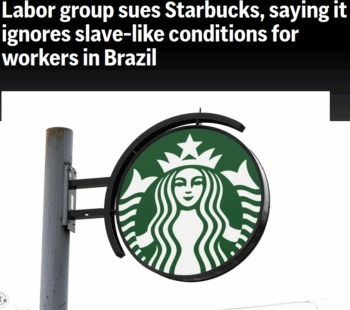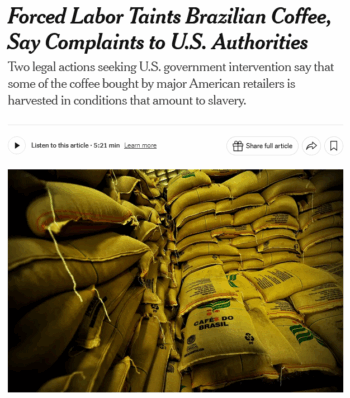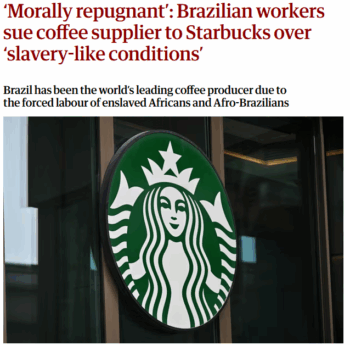It seems like an odd moment for the US media to do a hit job on Brazil’s coffee industry.
Protective tariffs have been used since the 1800s in the US to protect domestic industry and increase employment. As Raúl Prebisch, Celso Furtado and other economists influential on Latin America’s “Pink Tide” argued, tariffs are also fundamental for Global South nations to escape from the prison of agricultural commodity export dependence, by enabling them to industrialize through import substitution.
Regardless of heterodox economists’ arguments in favor of import tariffs, however, there seems to be little sense in the US government imposing tariffs on products that can never be produced nationally, like bananas or coffee. This is what it did on April 2—the day after April Fool’s day—when President Trump announced new, blanket tariffs on all imports from 57 countries around the world.
Compared to other countries (like Cambodia or Madagascar) in the Global South, Brazil, which had a trade deficit with the United States in 2024, got off relatively easy, with 10%. One sector that will hurt, however, is coffee.
Brazil is the largest coffee producer in the world, and its largest export market is the United States. Brazil exported $1.8 billion, or 15% of its total coffee production, to the United States in 2024. In 2025, US consumers will have to foot the bill for a 10% tariff on a product whose price has already increased by 6.9% this year, due to the effects of climate change weather events on last year’s harvest cycle.
‘Harvested by trafficked slaves’

AP (4/24/25): “Eight Brazilian coffee workers…allege… they were put in filthy housing and the cost of their transportation, food and equipment was deducted from their pay.”
The US’s new tariffs on Brazil came into effect on April 5. Nineteen days later, a Delaware-based NGO named Coffee Watch, which provides no funding transparency on its website, conducted a media blitz against Brazil’s coffee industry. It issued a letter to the US Customs and Border Protection, demanding a halt on all Brazilian coffee imports to the United States. On April 24, the New York Times, Guardian and AP, which sells content to hundreds of sites and newspapers, ran simultaneous articles on Coffee Watch’s campaign.
Coffee Watch built on the stories of eight workers rescued by Brazilian federal labor inspectors from what the Brazil’s government called “slave-like conditions.” These workers came from five of Brazil’s 330,000 coffee farms. Coffee Watch and other quoted experts extrapolated from their cases to advocate for a complete halt of Brazilian coffee exports to the United States—itself a country where hundreds of thousands of undocumented immigrants work on farms under conditions that could be categorized as “slave-like” within Brazil’s legal framework.
The New York Times article (4/24/25), headlined “Forced Labor Taints Brazilian Coffee, Say Complaints to US Authorities,” detailed a lawsuit filed against Northern companies, including Starbucks, Nestlé and Dunkin’, on behalf of eight workers from five of the 19,000 farms affiliated with the Cooxupé cooperative. The article, by the Times‘ Ephrat Livni, went on to describe Coffee Watch’s efforts to force the US Customs and Border Protection to block all coffee entering from Brazil.
“This isn’t about a few bad actors,” the Times quoted Etelle Higonnet, the founder and director of Coffee Watch. “We’re exposing an entrenched system that traps millions in extreme poverty and thousands in outright slavery.”
The subheading of the Guardian article (4/24/25) read, “Brazil has been the world’s leading coffee producer due to the forced labor of enslaved Africans and Afro-Brazilians.”
AP (4/24/25) quoted International Rights Advocates founder Terry Collingsworth, who is representing the plaintiffs, saying, “Consumers are paying obscene amounts for a cup of Starbucks coffee that was harvested by trafficked slaves.”
More labor rights than US

New York Times (4/24/25): “The laborers end up…harvesting coffee under conditions not so different from those of their enslaved forebears.”
From reporting like this, the casual reader might think that Brazil’s coffee industry is based on slave labor, and that many or most of the people who work picking coffee are enslaved. This is a greatly misleading depiction of the very real labor issues in Brazil.
Although landless agricultural workers in Brazil, like nearly everywhere else in the world, suffer from low wages, lack of job stability and oppressive labor conditions, Brazil’s coffee farm workers have significantly better labor rights than farm workers in the United States. Nearly half of the US farm workforce are undocumented immigrants with no labor rights whatsoever, in fear of being arrested, imprisoned and/or deported by ICE.
The arguments advanced to justify banning coffee imports from Brazil to the US rely on outliers representing a tiny portion of the workforce, not the norm, as these sensational articles present.
Brazil’s coffee industry provides 580,000 full time jobs and millions of harvest-season temp jobs. According to Coffee Watch’s own letter, the highest number of workers rescued from “slave-like conditions” in any year since 2003 was 333, in 2023.
When Higonnet tells the Times that “thousands” of coffee workers in Brazil work in “outright slavery” (a more than semantic leap from the Brazilian legal category of “slave-like” working conditions), she is misleadingly referring to Coffee Watch’s composite figure of 4,128, cited in Coffee Watch’s letter to Customs as the total number of coffee workers rescued from “slave-like” conditions between 2003 and 2024.
Whereas the number of 221 workers rescued from slave-like conditions in 2024 certainly doesn’t represent the total number of workers subjected to those conditions that year, no methodology is presented to estimate what that undercount might be. The number of Brazil’s federal labor inspectors is 2,800, including 900 new hires this year, and the number estimated by IPEA needed to bring Brazil up to international standards is 3,700, so an undercount is a clear possibility, but it’s certainly a far cry from Collingsworth’s insinuation that most Starbucks coffee purchased from Brazil was produced by “trafficked slaves.”
On the back of slave labor

Guardian (4/24/25): “Starbucks charges like $6 for a cup of coffee, where most of that has been harvested by forced laborers and child laborers.”
Like the United States and most other countries in the Americas, Brazil was built on the back of slave labor, and was the last country to eradicate it, in 1888. The legacy of this today is that it has the highest Afro-descendent population outside of Africa, and huge problems of structural racism, including large but shrinking levels of inequality, and lack of opportunities for the poorest segments of society, which are disproportionately constituted of the 56% of the nation’s population that is Afro-Brazilian.
There is a large population of landless rural workers, who with support from the Landless Workers’ Movement (MST in Portuguese) and the National Confederation of Agricultural Workers (CONTAG) have been successfully fighting for land rights since the end of the US-backed military dictatorship in 1985. Today, although millions of landless rural workers toil away in degrading conditions for low wages on farms producing export commodity crops like coffee, sugar and soy—some of which cross the line into violating Brazil’s slave-labor legislation—there is also a growing population of millions of family farmers who don’t employ anyone.
Today, 78% of Brazil’s 330,000 coffee farms, producing around 48% of the total amount of coffee, are small-holder family farms. If Coffee Watch succeeds in lobbying the US government to halt imports from Brazil, the hardest-hit sector will be the same group that fair trade advocates work to empower. Without millions ferreted away in investment funds and offshore holdings, it’s the family farms that run the risk of financial ruin, not the agribusiness plantations, or companies like Starbucks and Nestlé that work with them. When small farmers lose their livelihood, they often become rural workers themselves, which, as Coffee Watch’s own letter to Border Patrol demonstrates, are among the lowest-paid and most vulnerable labor sectors in Brazil.
Based on the actions of five farms that belong to a cooperative of 19,000 of them, Coffee Watch and the media organizations supporting its campaign are targeting an industry largely composed of family farmers. It’s reminiscent of Operation Car Wash, an “anti-corruption” campaign backed by the US DoJ that bankrupted Brazil’s five largest construction and engineering companies, and caused 4.4 million direct and indirect job losses, under the guise of punishing a handful of corrupt business executives.
Just as was the case with corruption in the construction industry, the directors of the farms, the cooperative and the US corporations they sell to deserve to be held liable for their labor crimes. But punishing the industry as a whole will cause disproportionate suffering for the working class and poor, and raise Brazil’s level of extreme poverty.
Different definitions
Coffee Watch’s letter to acting Customs Commissioner Pete R. Flores cited US and International Labor Organization (ILO) legislation on slave labor used to justify the demand to block coffee imports from Brazil, but uses the Brazilian federal government’s much wider definition of “slave-like” labor conditions for the facts and figures used to back its argument.
Brazil, a nation with a long history of slavery and oppressive labor conditions in rural areas, first recognized modern slavery as a problem in 1995, and widened its definition of “slave-like” labor in 2003 under President Lula da Silva. It created a series of enforcement mechanisms to hold companies accountable for violating labor laws, including a “dirty list” of companies convicted of using slave labor. These employers are required to pay a minimum of 20 months salary at minimum wage to each rescued worker, as well as court fines, and can face up to eight years in prison.
Companies stay on the dirty list for two years and, during this time, are blocked from receiving government contracts or credit. Among the best-known companies that have appeared on the list is FEMSA, the world’s largest bottler of Coca-Cola. FEMSA was put on the list in 2018 after labor inspectors discovered truckers and warehouse workers at one of its Brazilian plants were being forced to work between 80 and 140 hours of overtime per month.
This was one of many cases in which “slave-like” working conditions, although oppressive and illegal, did not mean they were being held captive or forced to work for no remuneration. Brazil’s definition of slave-like working conditions has some overlap with US and ILO law, for example, holding workers in captivity and forcing them to work for very low or no wages. But it also includes things that are legal in the US, even for those US agricultural workers who are not undocumented, let alone the US’s 800,000 prison slave laborers.
As Brazil’s National Justice Council explains, the 2003 change in Brazil’s definition of slave labor represents
significant progress in the fight against this social problem, because it goes beyond lack of freedom, expanding the criminal definition of slavery to include cases of subjection to degrading working conditions, exhaustive work hours or debt bondage.
Coffee Watch’s own letter to Flores states:
The Brazilian approach to forced labor is somewhat more expansive than the ILO’s, as it may allow for prosecution of employers who subject workers to extremely degrading conditions, regardless of whether coercion was present in the employment relationship.
Any single violation of Brazil’s different criteria for slave-like working conditions makes the employer liable. This can include things like excessively long work days, not having an adequate number of bathrooms for the number of workers, making workers rent gloves and other safety equipment from the employer, not compensating workers for transportation to and from the work site, and not providing an adequate amount of drinking water. It would be easy enough for an organization such as Coffee Watch to verify this, but it’s a fair assumption to make that at least some of the coffee workers rescued from slave-like conditions since 2003 were victims of oppressive labor conditions that would not constitute slave labor by ILO or US legal criteria.
Landless rural laborers
This is in no way meant to minimize the oppression of those rural workers in Brazil’s coffee trade who are working in what Brazil’s government calls slave-like conditions. With over 1 million people employed in the sector, however, their situation is an outlier. Much more troublesome are the low wages and lousy working conditions that represent the norm in the industry—especially the fact that most temporary harvest laborers work off the books, outside of many of the safeguards in place to protect worker rights.
Another problem is the low number of labor inspectors—the result of six years of gutting of the Labor Ministry by neoliberal presidents Michel Temer and Jair Bolsonaro, who, thanks to a constitutional amendment passed in 2017, left the government with neoliberal spending caps. These were only partially dismantled by a compromise amendment called the New Fiscal Framework, enacted as Lula returned to power in 2023.
Capping social spending increases at 2.5% per year above inflation may have led to the compromise of only hiring 900 of the 1,800 inspectors needed to bring Brazil up to international labor standards, but the fact remains that Brazil has not reached the goal of one inspector for 10,000–15,000 workers recommended by the International Labor Organization.
Around the world, landless rural laborers are among the most oppressed, poorest members of the labor force. Nevertheless, Brazilian coffee farms are not regularly raided by masked government police and their workers thrown into prison camps. In this political juncture, US institutions have little moral standing to criticize labor rights for agricultural workers in other countries—especially in countries like Brazil, whose labor rights issues stem in part from the US-backed military dictatorship’s systematic campaign of arrest, torture and murder of labor union leaders.
Fundraising boost
The idea that Trump’s US Customs and Border Protection would act to increase the price of coffee right now, in the name of “human rights,” based on abuses in five coffee farms, is very unlikely. This exposes the move as a publicity stunt, clearly designed to boost fundraising and legitimacy for a new NGO.
If Coffee Watch were focused more on improving the lives of coffee workers than on institutional promotion, it could show solidarity by supporting the MST and CONTAG in their fight to help landless agricultural workers start their own farms.
Taking big corporations like Starbucks and Nestlé to task for failing to obey local labor laws is commendable. But given the long history of US NGOs acting as regime change cheerleaders for the US State Department in Latin America, the priority that many of these organizations place on self-advancement over benefiting their target populations, and the long, cushy relationship between sleazy corporations like ExxonMobil and NGOs like Transparency International USA, can human rights guidelines for the Global South established by a US organization with no funding transparency really be trusted?
You would think a publication like the New York Times would exercise enough due diligence to include the voice of, say, someone from Brazil’s DA office, or an official from an agency that works to monitor, punish and prevent occurrences of slave-like working conditions. Instead, it published a slightly modified press release from Coffee Watch, and the journalists involved probably thought they were doing their good deed for the month.
Featured image: Cachoeirinha farm in Nova Resende, Brazil, on the government’s “dirty list” for labor abuses (photo: Ministry of Labor and Employment).
This content originally appeared on FAIR and was authored by Brian Mier.